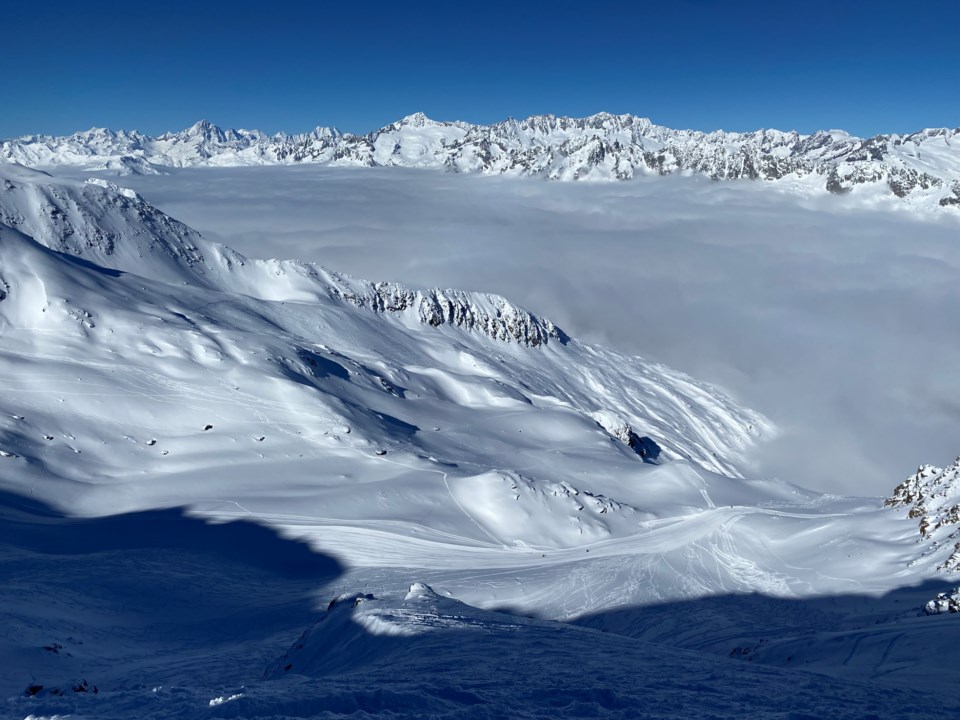While aspects of the Epic Pass have precipitated everything from awesome to awful in North American resorts, its best feature is the invitation to international travel. Being able to use the Epic Pass in Japan, Italy, France and Austria has opened up awesome options for North Americans looking for a cultural ski experience in storied mountains. The best overall is Switzerland, with one partner and two destinations to tempt the savvy skier. And no European ski experience ranks higher for ease of travel, efficiency, and high-grade food and sleep.
To begin, in 2025-26, various Epic Pass products will include five days at a new partner—Verbier 4 Vallées. This is an insane get—six resorts and 410 km of runs in Switzerland’s largest ski area, nestled in a natural snowbelt. Then there’s two actual Epic Pass resorts. First, venerable Crans-Montana, known for 300 sun-soaked days each year, glamour, World Cup speed events, and views of the Matterhorn and Mont Blanc. And next, the new colossus of Andermatt-Sedrun-Disintis, from which I recently returned. For adventurous Whistler skiers used to moving through large mountain landscapes the latter is your place. It was certainly mine.
On a mid-March day, Andermatt’s fabled Gemsstock felt strangely spacious. An unexpected 30 cm of fluff had yet to pack the peak’s two linked trams, which ran half-full to the 2,961-metre, glacier-rimmed summit. As I debarked, a handful of out-of-their-leaguers stared with eyebrows raised down steep, off-camber pistes toward the manicured embrace of lower chairlifts, while the ranks of giddy freeskiers normally scrambling off the Gemsstock were today as thin as the rarified air.
As I aimed for Felsental, an off-piste descent I’ve favoured over a quarter century of visiting, I was trailed by those with similar ambition. One was a guide leading an elder but capable woman, his hardened face resembling the crust of the Earth itself—molten fire bubbling beneath flinty eyes, creases at their corners a convolution of outdoor experience laid down over the years. As I stopped at the entrance, he leaned forward to tap a hidden rock with his pole, a universal gesture of caution. We flashed each other knowing grins and disappeared into our respective voids, certain it would be a long, wary—but rewarding—way down.
In an age of soft adventure, it’s hard to imagine a gnarly concatenation like the Gemsstock standing as centrepiece for yet another mega-resort, but happily for Epic Pass holders, such is the case. Locals, too. Stoic, long-resistant traditionalists, Andermatters were not only tolerating a sea-change in village life, but genuinely starry-eyed over the arrival of luxury hotels, moneyed clientele, and new lifts linking Andermatt to the once-moribund ski areas of Sedrun and Disentis, revitalizing all into the most changed resort in the Alps over the past 20 years. Call it a coda of economic salvation after the town’s main employer, the Swiss military, pulled up stakes after the Cold War, followed by the opening of a new train tunnel in 2016 that bypassed the valley.
Though nominally a ski resort, Andermatt also presents a realm of myth, legend and fantasy spun with Satan himself, Benedictine monks, a Russian army general, treasure-laden Irish earls, William Tell, Goethe, Elvis Presley, James Bond, and, most recently, Egyptian property developer Samih Sawiris, who opened the town’s transformation set-piece—the almost ethereal five-star Chedi hotel—in 2013. Clearly, it’s a town with tales to tell.
Despite the legion of comings-and-goings over the area’s history as a geographic and cultural crossroads between the four language and cultural areas of Switzerland, a high-end future is rapidly descending, raising the perennial question of whether the drive to get big or perish will leave powder-hounding guides and ski bums—who kept Andermatt afloat through the bad times—poor men in a rich man’s world, or beneficiaries of the renaissance.
The latter seemed the only thing on people’s radar when the next morning donned sunny with more new snow. Leaving my comfortable nest in the stylish Radisson Blu Reussen, a modern-Swiss-meets-Scando property anchoring a plaza of new development on the north end of town, I walked a couple minutes to the train station then strolled underground to an escalator that lifted me directly to the Nätschen-Gütsch gondola. Past Nätschen mid-station at 1,842 metres, skiing is all above treeline and, despite some southern aspects, snow and grooming typically good—the reason even beginners find the straightforward zig-zag of lifts and pistes that now carry you up and over the Oberalppass intoxicating.
Though originally smallish by Swiss standards, Andermatt had always seemed vast, mostly because you could ski off any aspect of the Gemsstock to land in a different valley, something best appreciated in sightlines from the Gütsch top station; another was the reverse view, from Gemsstock to the expansive Oberalp, the frequent intrusion of a tiny, sinuous, red train winding its way through the pass like a snowy model diorama delivering required perspective. Now that it’s all one ginormous ski domain, the feeling is only multiplied.
At Gütsch, I was greeted by a contemporary stone building containing two restaurants—The Japanese and Gütsch—that represent a new approach to on-mountain dining (beyond the country’s quotidian pizza, spaghetti and würst) to compliment the town’s growing gourmet scene. But I had other lunch plans, and it took me two more lifts and three wide-open runs to reach the Oberalppass, where I cradled a beer on the sun-soaked deck of Restaurant Piz Calmot contemplating a morning of a half-dozen empty powder runs that seemed, well, very epic indeed.
Leslie Anthony is a Whistler-based author, editor, biologist and bon vivant who has never met a mountain he didn’t like.




